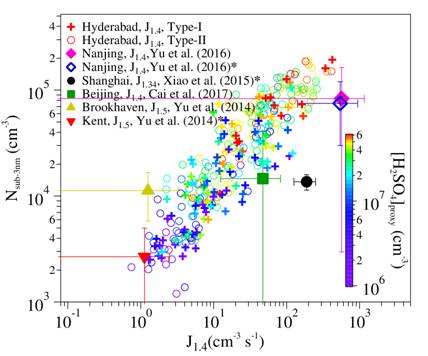Ministry of Science & Technology
Aerosol particles below 3 nm which can reach sizes having climatic impacts, formed frequently in urban locations in India
प्रविष्टि तिथि:
11 JUN 2021 4:14PM by PIB Delhi
Scientists tracing the concentration, size and evolution of aerosol particles smaller than 3 nanometres at an urban location in India have found frequent formation of sub-3nm aerosol particles in the atmosphere. This has critical importance as a major fraction of these newly formed particles can reach to sizes of cloud condensation nuclei where they have climatic impacts.
The formation of small molecular clusters of sub-3nm size is technically called aerosol nucleation, and subsequent growth of these newly formed clusters to the large sizes is called atmospheric new particle formation (NPF). NPF occurs everywhere in the terrestrial troposphere, and therefore it is a large source of aerosol numbers to the atmosphere. Though extensively studied globally using field observations, laboratory experiments and modelling approach, it is largely unexplored in India.
Scientists from the University of Hyderabad measured neutral sub-3nm particles for the first time at an urban location in India. Dr Vijay Kanawade and Mr Mathew Sebastian used AIRMODUS nano Condensation Nucleus Counter (nCNC) to measure particle size distribution in the size range of 1 to 3 nm.
In the study supported by the Department of Science & Technology (DST) under Climate Change Programme Division, they conducted continuous observations since January 2019 at the University of Hyderabad campus site and reported the formation rate of small molecular clusters in sub-3nm size regime, where aerosol nucleation triggers. This work has been recently published in the journal ‘Atmospheric Environment’.
The research showed that a pool of sub-3nm particles is often present in the atmosphere, but how fast these clusters grow depends on various factors. The scientists observed that only half of these events showed newly formed molecular clusters growing past 10 nm size. Thus particle size distributions display a conventional banana-shaped aerosol growth, which is indicative of regional NPF event.
The team found a strong positive correlation between sub-3nm particle concentrations and sulphuric acid concentrations, confirming the potential role of sulfuric acid in the formation of sub-3nm particles. While NPF often starts with sulphuric acid in the atmosphere, sulphuric acid alone fails to explain observed particle formation and growth rates in the atmosphere. Other vapours such as ammonia, amines and organics play a crucial role in the growth of newly formed particles. Moreover, these newly formed particles did not always grow to large sizes, and the team hypothesized that the particle growth was limited by lower concentrations of condensable vapours such as organic compounds, calling for research using state-of-the-art instrumentation to understand the mechanisms driving NPF in diverse environments across India.

Figure 1. Scatter plot of hourly averaged particle formation rate of 1.4 nm particles (J1.4) versus sub-nm particle concentrations (Nsub-3nm) as a function of sulfuric acid concentrations ([H2SO4]proxy) for Type-I (open circle) and Type-II (plus sign) NPF events in Hyderabad. The mean values of J1.4, Nsub-3nm, and [H2SO4]proxy for other sites in diverse environments across the globe are also plotted for comparison. * indicates winter-time measurements. The colour scale shows the concentration of [H2SO4]proxy.
Publication link:
https://doi.org/10.1016/j.atmosenv.2021.118460
****
SS/RP (DST Media Cell)
(रिलीज़ आईडी: 1726241)
आगंतुक पटल : 1179